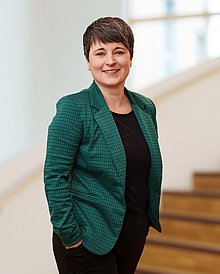The "satisfaction paradox": Why older people tend to be the happiest despite health complaints
"Happiness researcher" Tobias Esch explains from a neurobiological perspective how the feeling of happiness can change over the course of a lifetime.

It seems paradoxical: despite physical complaints and chronic illnesses, older people are generally happier and more satisfied than teenagers or young adults. Prof Dr Tobias Esch has developed a model that explains this so-called "satisfaction paradox" for the first time. His analysis shows: The life satisfaction of older people is biologically determined, but can still be "learnt".
In the renowned biology journal "Biology", Esch has recently published a policy paper that summarises the results of his almost 20 years of research into the brain's reward system and the experience of happiness. Esch distinguishes between three types of happiness, which vary in intensity depending on the stage of life: (A) the "desire system", (B) the "threat avoidance system" and finally (C) "not wanting" or remaining in the "here and now". The result is the so-called "ABC model" of happiness, which has been empirically proven by numerous studies.
According to this model, happiness is not a cognitive construct, but a feeling that is demonstrably based on the physiological activity of the brain's neurobiological reward and motivation systems. Traces of this system can even be found in the simplest of creatures.
How our sense of happiness changes over the years
"Happiness changes its 'colour' over the course of our lives," says Esch, summarising the results of his research: "In our youth, we seek pleasure and thrills, are creative, willing to take risks and eager to learn. Happiness in this stage of life is characterised by anticipation, pleasure and ecstasy."
In phase B, threat avoidance, most people experience demanding stress, for example due to a higher financial burden, professional challenges or their responsibilities as parents. During this period, satisfaction usually decreases. Young adults tend to make their happiness dependent on avoiding pain or threats, reports the happiness researcher: "We are vigilant and ready to face challenges and difficulties in order to protect our lives and those of our family." Happiness in this phase is more of a feeling of relief "when stress and 'unhappiness' take a break."
From around the age of 60 upwards, statistically even beyond the age of 80, people usually need little to be happy despite physical complaints, Esch has found: "The later stage of life is usually the point at which the euphoria and avoidance of stress turn into a deep, calming and lasting feeling of happiness and contentment."
"While momentary happiness is characterised by intense, pleasant and euphoric but fleeting moments, life satisfaction is more profound, enduring and subtle, and is characterised by feelings of acceptance, belonging, calm and arrival. It seems as if we get better and better at being satisfied and happy as we get older," summarises the physician, health researcher and founder of the Witten University Outpatient Clinic. Only a few years before death does life satisfaction statistically decrease again, e.g. due to the concentration of illnesses in the so-called 'fourth age'.
Happiness is biologically determined, but can be learnt
The development of happiness and satisfaction during the lifespan often resembles a U-curve, which appears to be independent of good health. The decline in life satisfaction from early adulthood to midlife is more pronounced in male participants than in females. The basic findings of higher life satisfaction in the second, supposedly 'better' half of life are shared by both men and women, but the specific shape of the curve differs. There may be many reasons for this, which have not yet been fully explained. Biological as well as psychosocial factors certainly play a role here.
Neurobiological processes therefore shape our 'maturation' over the course of our lives by chemically and biologically rewarding the 'right' behaviours and associated experiences. Nevertheless, this course of happiness is not completely predetermined, emphasises Esch: "Meditation and mindfulness techniques as well as religiosity and faith, for example, seem to be able to influence the course of happiness over time. Happiness can be moulded through practice."
"U-curve of happiness" demonstrable in almost all populations and countries of the world
The ABC model of reward and motivation and its relationship to happiness described by Tobias Esch at Witten/Herdecke University began with observations from basic research. It was derived, for example, from knowledge about which neurotransmitters appeared when in evolution and which metabolic pathways were linked to each other.
Direct insight into large clinical (empirical) longitudinal data sets, for example the Nurses Health Study (Harvard Medical School and others) or the Grant Study (Harvard Study of Adult Development) and the UK Million Women Study, confirmed the assumptions derived from the theoretical model.
Current findings now show that such a U-curve of happiness can be found in almost all populations and countries around the world. The data from Witten/Herdecke University reported in "Biology" confirm these findings in the German population.
Source: Esch, T. The ABC Model of Happiness-Neurobiological Aspects of Motivation and Positive Mood, and Their Dynamic Changes through Practice, the Course of Life. Biology 2022, 11, 843 (https://www.mdpi.com/2079-7737/11/6/843)
Photos for download
Contact person

Lucy Mindnich, M. A.
Communications Officer
Administration | Communication & Marketing
Alfred-Herrhausen-Straße 48
58455 Witten
Room number: 2.F05
